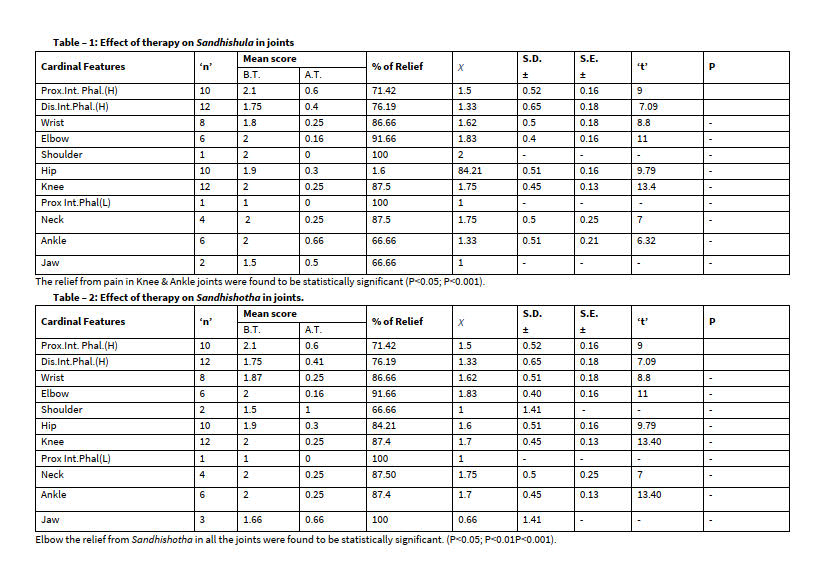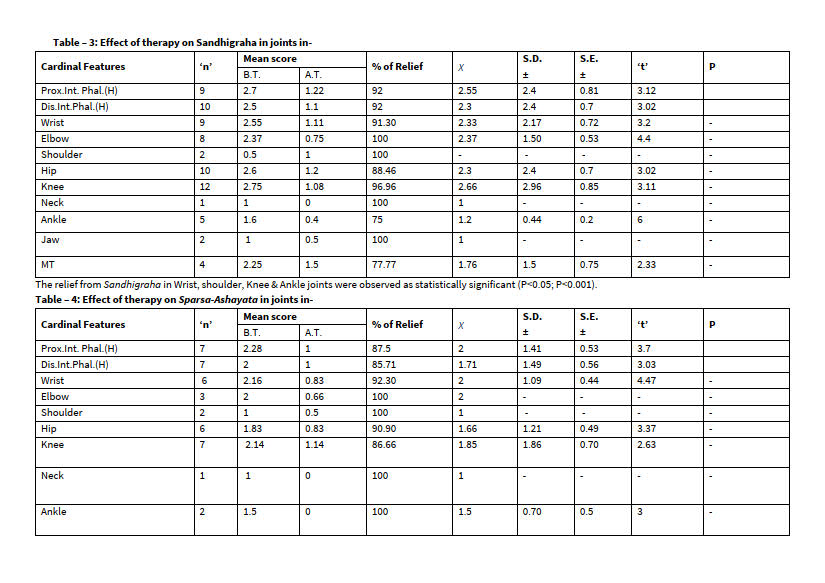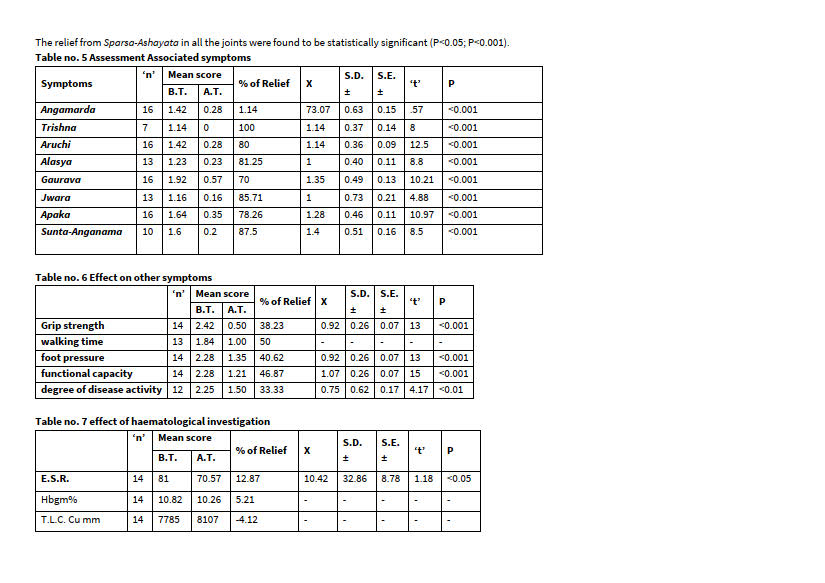Original Article
Year: 2021 |Volume: 2 | Issue: 01 |Pages: 1-9
Clinical Study of Tindukamrita capsule with Nirgundi Patra Panda Sweda in the management on Amavata
About Author
Correspondence Address:
Dr. Shakuntala Sundi - MD, department of kayachikitsa, IPGT and RA, GAU, senior medical officer in Jharkhand Govt. Email -Sundisakuntala@gmail.com
Date of Acceptance: 2021-01-05
Date of Publication:2021-02-10
Article-ID:IJIM_48_02_21 http://ijim.co.in
Source of Support: NIL
Conflict of Interest: NIL
How To Cite This Article: Shakuntala Sundi et al. Clinical Study of Tindukamrita capsule with Nirgundi Patra Panda Sweda in the management on AmavataInt. J Ind. Med. 2021;2(1):1-9
Abstract
There are so many dreadful diseases prevalent in medical science. The scopes of therapeutic measures are limited even extreme advancement of modern bio-medical sciences. The Rheumatological disorder is such a group of diseases which has no specific medical management in any type of therapeuties Amavata is the particular type of disease which is the mentioned in Ayurveda since the period of Madhavakara under the category of vata-kaphaja disorders. The Ayurvedic approach to the treatment is the need of our as no system is successful in providing the complete cure to the Rheumatological disorder. Still Amavata is a challenging and a burning problem of medical science. In this research work 27 patients were registered from OPD and IPD of IPGT and RA, these patients were given Tindukamrita capsule in the doses of 500gm two capsule three times a day for 30 days, along with Nirgundi Patra Pinda Sweda in 28 days. Results shows that significant decrease in the sign and symptoms of Amavata after treatment regimen.
Keywords: Nirgundi Patra Pinda Sweda, Tindukamrita capsule, Amavata, Rheumatoid arthritis
Introduction
Vata dosha along with Ama is termed as Amavata. It indicates the propulsion of Ama by vitiated vata in the entire body and gets lodged in Sandhisthana producing Amavata.1 The clinical presentation of Amavata closely can be corelated with Rheumetological disorders called rheumatoid arthritis, in accordance with their similarities on clinical features, like pain, swelling. stiffness, fever, redness, general debility ect.2 Rheumatoid Arthritis is a chronic multisystem disease of unknown cause. Characteristic features of which persistent inflammatory synovitis is usually involving peripheral joints in a symmetric distribution. The prevalence of RA is approxi. 0.06 to 3.4%. Reliable with data from other regions, RA was more prevalent among urban than rural populations, and among women than men. The women:men prevalence ratio ranged from 1.3:1 to 12.5:1, which proposes prominent differences from the global average of 2:1.3 In some patients with rheumatoid arthritis, chronic inflammation leads to the destruction of the cartilage, bone and ligaments causing deformity of the joints. Damage to the joints can occur early in the disease and be progressive. Moreover, studies have shown that the progressive damage to the joints does not necessarily correlate with the degree of pain, stiffness, or swelling present in the joints.4 In the present clinical study effect of selected drugs Tindukamrita capsule and Nirgundi Patra Pinda Sweada were evaluated. For Patrapinda, Nirgundi is used traditionally and very effective and its vedana sthapaka, Vatashamaka and Ama pachana properties.5 Which help to prognosis of Amavata. Also Nirgundi Patra is easy to prepare and easily available. Effect of Snehana and Swedana both can be accomplished by Nirgundi Patra Pinda Sweda is an effective procedure to reduce the Sandhishoola, Sandnistabdhata.6 In shamana drug Tindukamrita capsule is used. It is used in practice, it is a combination of simple drug i.e. Goghrita shdhita kupilu is specifically indicated in Amavata due to its Kaphavata Shamaka and vedana sthapana properties,7,8 and Guduchi is also having Balya and vedana sthapana properties. Additionally both rugs are specifically good for kaphavata condition and having Rasayana properties as well.9
Aims and Objectives:
- To evaluate the role of Tindukamrita capsule with Nirgundi patda panda sweda on Amavata.
- To review the disease Amavata in ayurvedic classics.
Materials and Methods
Row drug Nirgundi, Kupilu and Guduchi is collected from pharmacy of IPGT &RA, GAU Jamnagar, and authenticated by Dravyaguna department, Tindukamrita capsule prepared according to the prescribed method in the pharmacy.
Selection of Criteria: Patients having classical features of Amavata like Angamarda, Aruchi, Gaurava, Trishna, Jwara, Shula, Shotha etc. were taken for the present work. The detailed research proforma was prepared incorporating all the signs and symptoms seen in the disease.
Patients were selected from the age group of 18-60 years, irrespective of sex, religion and occupation etc.
The base of criteria led down by American Rheumatism Association (ARA) was also taken into consideration.
Exclusion Criteria:
Chronicity for more than 10 years.
Having severe crippling deformity.
Having cardiac disease, Pulmonary.T.B, Diabetes mellitus etc.
Age less than 18 yrs and more than 60 years.
Investigations: For the purpose of assessing the general condition of the patient and to exclude other pathologies like, Rheumatoid factor, Hematological Investigations and Biochemical Investigations.
Study design: Total 27 patients were registered in Tindukamrita capsule group, amongst them 16 patients had completed the treatment and 11 left against medical advice. The patients of this group were given Tindukamrita capsule in the doses of 500gm two vati three times a day for 30 days, along with Nirgundi Patra Pinda Sweda in 28 days.
Criteria for Assessment: In this study an effort has been made to follow the guideline laid down by the classical texts of Ayurveda as well as American Rheumatism Association (1988).
Table no, 1 – Degree of disease activity to be assessed on the basis of American Rheumatism Association criteria (modified
|
Grade |
0 |
1 |
2 |
3 |
|
Fatigue |
Not there |
Work full time despite fatigue |
Patient must interrupt work to rest |
Fatigued at rest |
|
Grip strength |
200 mmHg or more |
198 to 120mmHg |
118 to 70 mmHg |
Under 70mmHg |
|
Spread of joints |
Not there |
0 to 50 |
51 to 100 |
Over 100 |
|
Westergren ESR (in 1st hour) |
0 to 20 |
21 to 50 |
50 to 100 |
Above 100 |
|
Haemoglobin (gm %) |
12.5 or more |
12.4 to 11 |
10.9 to 9.5 |
<9.5 |
|
General function |
All activity without difficulty |
Most activity but with difficulty |
Few activity cares for self |
Little self care mainly on chair & bed |
|
Patients estimate |
Fine |
Almost well |
Pretty good |
Pretty bad |
|
Physicians estimate |
Inactive |
Minimally active |
Moderately active |
Severely active |
|
Apart from this criteria of ARA (1987) two other criteria were added here. |
||||
|
Foot pressure |
36-40 kg |
31-35 kg |
26-30 kg |
<20 kg |
|
Walking time (for 25 feet) |
15–20 sec. |
21-30 sec. |
31-40 sec. |
>40 sec. |
Assessment of cardinal symptoms like:
- Sandhishoola (Pain in joints)
- Sandhishotha (Swelling in joints)
- Sparshasahyata (Tenderness in joints)
- Sandhigraha (Stiffness in joints)
Assessment Associated symptoms like
Jwara, Alasya, Gaurava, Asyavairasya, Daurbalya, Akarmanyata, Utsahahani, Angamarda, Daha, Trishna .

IMG 1

IMG 2

IMG 3
Discussion
Chikitsa sutra of Amavata is langhana, swedana, Tikta-katu-Deepana drugs, virechana etc. the treatment is based on Ama pachana and amelioration of vitiated Vata.10 The prepared shaman yoga (Tindukamrita capsule) is well known and popular drug which has possess sothahara and shoola prashaman qualities and gives desired Rasayana effect. The drug suitably acts one vitiated Vata & Kapha and produces the ultimate effect. Kupilu also is well known Rasayana and which has possessed shothahara and shula prashamana qualities and gives desired Rasayan effect. The drug suitably acts on vitiated vata & kapha and produce the ultimate effect.Guduchi is also having Balya and vedna sthapana properties. Additionally both drugs are specially good for Kaphavata condition and having Rasayana propertirs as well.
Tindukamrita capsule gives highly significant improvement in sign and symptoms of disease, which includes symptom like Sandhishula, Sandhishotha, Sandhigraha, Angamarda, Aruchi, Trishna, Alasya, Gaurava, Jwara, Daurbalya,Vibandha, Bahumutrata, Hridgraha, Usnata Around Joints, Griping strength, Foot pressure, Functional capacity, were statistically highly significant and other hematological parameters were statistical insignificant. out of 16patients, marked remission was reported in 2 patients (12.5%) while 10 patients (62.5%) got moderate improvement and 4 patients (25%) got mild improvement. None of the patient was found complete and unchanged in both the groups. The improvement was statistically highly significant may be because of the properties of kupilu like vedanasthapana, Deepana, Pachana which helps to relieve the shoola and for the digestion of the Ama. Also Properties of kupilu like immuonomodulator, Antinociceptive, Anti-inflammatory, Anti-allergic11 which helps to over come the immunological derangement induced RA by boosting once immunity which brakes the pathogenesis of the disease.
Probable mode of action of Nirgundi Patra Pinda Sweda: Three phenomenon takes place which are valuable from the scientific point of view:
Advocation of heat in the form of warm pottali repeatedly on affected surface. Lastly the light massage on the fomented parts.
- By the above procedure the affect of therapy can be assumed in two ways:
- By the Physical manipulation.
- By the chosen drug.
Physical Manipulation:
- To help relieving the pain by increased blood circulation is that area.
- Relaxing adjacent structure.
- Checking the further process of the disease.
- And also enhance the absorption of the drug material advocated during the process.
Effect of the therapeutic Drug:12 The effect of the choosen drug with the heat had administration may produce the analgesic effect by diverted stimuli. The thermo-stimulation applied above the site of region may possibly replace the already existing pain sensation there by producing the hypo-analgesic effect. In this course of Nirgundi Patra Pinda Sweda the administration of the drug is made in two ways:
- Oleation by the Nirgundi leaves tied in the form of Pottali.
- The fried Nirgundi leaves tried in the form of Pottali
The drug Nirgundi here administered in the form of oil and cell membrane is lipid in Nature, the higher the lipid solubility of the drug the super the concentration gradient within the membrane and thus greater will be the driving force for the diffusion of the substance across the membrane. Due to Vedanasthapaana, Vishaghanna, properties of Nirgundi helps in reducing the symptoms like shoola, shootha Jwara and also increases the immunity of the individual.12Also better relief was observed in shoola,Gaurava, Sthabdata, shootha by Nirgundi Patra Pinda Sweda in both the groups due to above mention properties.
Conclusion
Tindukamrita capsule drugs effective on Amavata because both have such type of properties like Rasa, Guna, Virya, and Vipaka which can remove the samprapti Ghatak of Amavata. kupilu has vedanasthapana, Deepana, Pachana properties which helps to relieves the shoola & digestion of the Ama. Also properties guduchi like immunomodulator, Rasayana, helps to over come the immunological derangement induced Rheumatoid Arthritis. Nirgundi Patra Pinda Sweda local swedan therapy used in mostly in practice was very effective. Better relief was observed in symptoms like shoola, Gaurava, Stabdhata, Shootha by treatment regimen at significant level.
References
- Sri Jayakrishna, Ayurveda series 102, Illustrated Susrutha Samhitha nidan sthan (Text, EnglishTranslation, Notes, Appendices and Index) Vol I, Chaukamba Orientalia Varanasi 2012: pg 287
- Rastogi, Sanjeev. "Ayurvedic Rheumatology: Quo vadimus." Rastogi S, Chaukhambha Vishwabharati, Varanasi (2020): 19-26.
- Almoallim, Hani, et al. "A Review of the Prevalence and Unmet Needs in the Management of Rheumatoid Arthritis in Africa and the Middle East." Rheumatology and Therapy (2020): 1-16.
- Kim, Ji-Won, and Chang-Hee Suh. "Systemic Manifestations and Complications in Patients with Rheumatoid Arthritis." (2020): 2008.
- Dr. P.L. Hegde, A Text book of Dravyaguna vijnana, vol II, Chaukamba Sanskrit Sansthan, 2017 (English) ;p-615.
- Surendran E, Panchakarma, A guide totreatment procedure in ayurveda,1stEdi-tion, Kottakalam, Vaidyaratnam P.S.Vari-er Ayurveda College, 2006, page no 322
- Akbar, Shahid. "Strychnos nux-vomica L.(Loganiaceae)." Handbook of 200 Medicinal Plants. Springer, Cham, 2020. 1689-1697.
- Mitra, Swarnendu, V. J. Shukla, and Rabinarayan Acharya. "Effect of Shodhana (processing) on Kupeelu (Strychnos nux-vomica Linn.) with special reference to strychnine and brucine content." Ayu 32.3 (2011): 402.
- Acharya, R. N., M. M. Buha, and N. H. Sojitra. "Guduchi (Tinospora cordifolia (Willd.) Miers): A Comprehensive Review of its Internal Administration." (2020).
- Tripathi indradeva, editor Dwivedy Ramanath, Ch.25, Reprint Ed. Chaukhambha Sanskrit Bhawan ;2014; 166
- Razzaq, Aroona, et al. "Strychnos nux-vomica L. seed preparation promotes functional recovery and attenuates oxidative stress in a mouse model of sciatic nerve crush injury." BMC Complementary Medicine and Therapies 20.1 (2020): 1-11.
- Kumar, Parveen, and Smita Kumari. "Pharmacological Properties Of Nirgundi: A Review." International Journal of Ayurveda and Pharma Research (2020): 68-73.

